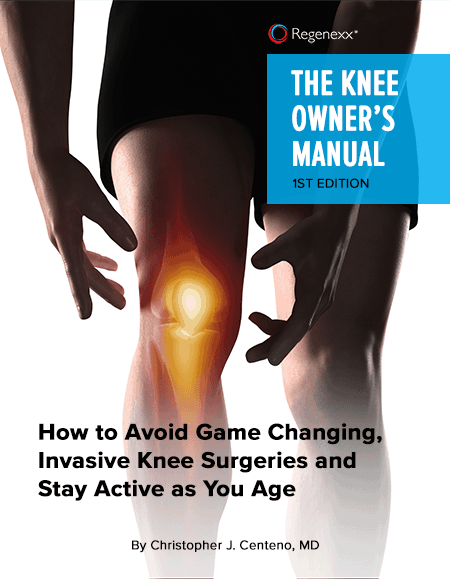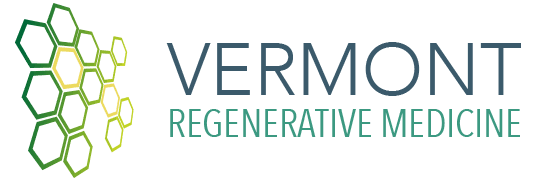CONTACT US. 802-859-0000
We understand how it feels to be frustrated by knee pain.
You may feel frustrated, anxious, and afraid. Feeling like you might not get to participate in activities you’ve always enjoyed, fearful that you might need surgery that could affect you for the rest of your life.

Are you frustrated by pain? Afraid you might need life-altering surgery?
You’re not alone. We can help.
Complete this short form and get your FREE copy of The Knee Owner’s Manual, plus receive valuable information that can help you avoid invasive surgery.
Partial knee menisectomy is a very common surgery that involves removing the torn part of the meniscus. The meniscus is a natural shock absorber for the knee. In fact, in America alone, we perform about 700,000 of these surgeries per year, making it one of the most common orthopedic surgeries. While most patients think they’re getting a meniscus repair procedure, the truth is, 96% of these surgeries just remove a piece of the shock absorber, leaving your knee less protected.
There have been many high-quality research studies over the past decade or more that were designed to answer the specific question, “Is surgery necessary for a torn meniscus?” What did they show? All three large studies showed that meniscus surgery was not effective or no better than just physical therapy.
We offer innovative non-surgical procedures that may help decrease pain and improve knee function and mobility without the need for surgery.
Meniscus surgery is traumatic and carries associated risks. Even successful surgeries require months of painful rehab to regain strength and mobility. After surgery, most patients will be on crutches, wear a brace, or some combination of both for several weeks before returning back to normal activity. The recovery time and rehabilitation period may be extended up to six weeks with a knee brace or crutches.
Keep in mind that there may even be some complications associated with meniscus surgery, prolonging the recovery period even more. This includes complications with anesthesia, such as respiratory or cardiac malfunction, infections, and injury to nerves and blood vessels, fracture, weakness, stiffness or instability of the joint, inability to repair the meniscus, repeated rupture of the meniscus, or the need for additional surgeries.
Can you ever truly recover from parts of your knee meniscus being removed surgically? In the long run, almost all meniscus surgeries accelerate degeneration that leads to osteoarthritis and exacerbate the biomechanical problems that initially led to the need for the surgery.
Meniscus tears are like wrinkles; they are unavoidable. Some of us get more of them at a young age and some of us don’t get a lot of them until we’re older. The meniscus gets small tears as we age and as the knee joint begins to wear out. For example, in middle-aged and elderly patients, taking an MRI of patients with no knee pain and those with ongoing knee pain will reveal that both groups have about the same amount of meniscus tears. If these things usually don’t cause pain, why are we operating on them? If our surgeries are no better than fake surgeries, why are we placing all of these patients at the risk of surgical complications?
Recent research shows that some of the most popular orthopedic knee surgeries, including meniscectomies, have no benefit and are not more effective than placebo or sham surgery. But can a meniscus tear heal on its own when left untreated? Non-surgical treatments for meniscus tears for healing on their own include physical therapy, rest, ice, compression and elevation. Interventional orthopedics also provides a non-surgical injection alternative that may prove beneficial in reducing pain and improving function.
Have you been told that invasive surgery is your only option to fix your torn ACL? Getting your ACL replaced permanently alters the mechanics of the knee joint. You have other options when it comes to treating your ACL injury. In fact, about 70% of all ACL tears that currently get surgery could have been treated with a precise injection.
Your body is built to repair itself and our goal is to save your ACL, not replace it. We offer a non-surgical alternative for ACL tears that requires advanced injection skills using X-ray guidance, which may aide the healing of your ACL tear, while reducing pain and increasing function.
Multiple studies show that meniscus surgery doesn’t work.
If your MRI shows a meniscus tear, you might be asking: Do I need surgery?
But here’s the more important question: Is the torn meniscus causing my knee pain?

Vermont Regenerative Medicine Doctors
Dr. Jonathan E. Fenton obtained an undergraduate degree with highest honors in Anatomy and Biomechanics at New York University, and his D.O. degree at the New York College of Osteopathic Medicine. Dr. Fenton is residency trained and board certified in Physical Medicine and Rehabilitation, and fellowship trained and board certified in NeuroMusculoskeletal Medicine and Osteopathic Manipulation. He currently practices Regenerative Interventional Orthopedic Medicine in Winooski, Vermont, and he is a visiting Physician at Regenexx Cayman. Dr. Fenton has been performing fluoroscopic (x-ray) and ultrasound guided injections since 2003, Platelet Rich Plasma injections since 2006, and bone marrow stem cell injections since 2012. To date he has successfully completed over 120 stem cell procedures and well over 1,500 PRP procedures for a variety of joint, ligament, tendon and spine conditions. Dr. Fenton teaches orthopedic medicine and diagnostic and interventional musculoskeletal ultrasound for several organization across the USA and Mexico. He was the ultrasound course director for the American Association of Orthopaedic Medicine (US guided live injection course for physicians). He has also taught many Regenexx network physicians about diagnostic and interventional ultrasound. Dr. Fenton’s protocol for hip dilation and mobilization are now part of the official Regenexx hip protocol. Biomechanics of sports performance and injuries, use of dynamic ultrasound to evaluate for joint stability, and the role of hormonal imbalances in the development of musculoskeletal disorders are a few of Dr. Fenton’s special interests. He also attained a host of board certifications, including Physical Medicine and Rehabilitation (double boarded), Neuromusculoskeletal Medicine and Osteopathic Manipulative Medicine, Diagnostic Musculoskeletal Sonography, and Orthopaedic Medicine. Dr. Fenton is an adjunct clinical assistant professor at NY College of Osteopathic Medicine, and teaches medical students, residents, and fellows from several medical schools. He is a board member and Secretary Treasurer of the American Association of Orthopaedic Medicine. He maintains active memberships in numerous professional societies, including the American Academy of Physical Medicine and Rehabilitation, the American College of Osteopathic Physical Medicine and Rehabilitation, the American Academy of Osteopathy, the American Association of Orthopaedic Medicine, and the American Institute for Ultrasound in Medicine. Dr. Fenton is an avid bicyclist and alpine skier, as well as a former professional ski instructor, and lives with his family in the Champlain Valley of northwestern Vermont.
Areas treated: Foot & Ankle, Hip, Knee, Lumbar Spine, Shoulder, Elbow, Hand & Wrist
Kelsey Albert, DO is a fellowship-trained, board-certified physical medicine and rehabilitation (PM&R) physician specializing in sports, spine, and orthopedic regenerative medicine. She strives to maximize function, performance, and quality of life for her patients and help them stay engaged in the activities and sports that they love.
Dr. Albert graduated from Union College in New York magna cum laude with a degree in neuroscience and then obtained her medical degree from the University of New England College of Osteopathic Medicine in Maine. Following medical school, she completed her residency at Albany Medical Center in New York, where she served as chief resident. She then continued her training in Napa, California for a specialized fellowship in Interventional Spine, Sports and Regenerative Medicine where she worked with Dr. Marko Bodor to refine her skills in image-guided injections, utilizing both ultrasound and fluoroscopy.
Prior to her medical career, Dr. Albert grew up skiing in Killington, Vermont and competed as a freestyle/mogul skier at the World Cup level. After years of training, she is fortunate enough to return to Vermont as a Regenexx physician to practice medicine with her mentor Dr. Jonathon Fenton at Vermont Regenerative Medicine in Winooski, VT. Beyond her professional pursuits, Dr. Albert remains an outdoor enthusiast and enjoys mountain biking, backcountry skiing and adventuring with her friends and family.
Areas treated: Lumbar Spine, Thoracic Spine, Cervical Spine (Not Upper Cervical or CCI)*
*DISCLAIMER: Like all medical procedures, Regenexx® Procedures have a success and failure rate. Patient reviews and testimonials on this site should not be interpreted as a statement on the effectiveness of our treatments for anyone else.
Providers listed on the Regenexx website are for informational purposes only and are not a recommendation from Regenexx for a specific provider or a guarantee of the outcome of any treatment you receive.


